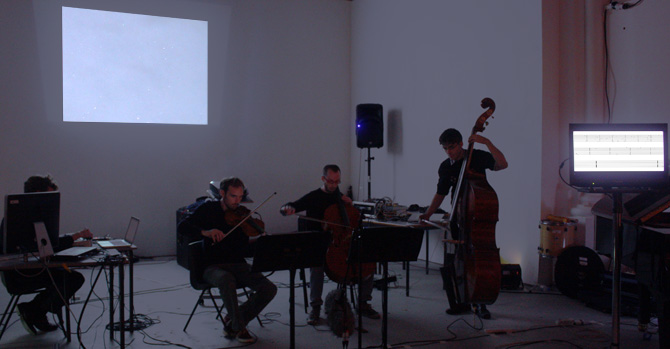Technical description of the notation, by Trevor Shearer
- Dust Music is a response to a video film I made of house dust caught in a ray of sunlight. The close-up film shows a soup of particles that, as we all know, are only occasionally apparent, depending on a particular viewpoint. The indeterminacy of these particles – their complete randomness – made me think of its opposite; a structure. The appearance of particles in a single frame of film could be plotted onto a series of staves overlaid on the image and become a notation that somebody else could interpret. The Fibonacci Series seemed an ideal way of identifying a manageable number of frames (still images from a total of nearly 6,000. also the series would rule out any choice over the selection (other than that of the series itself, as a means)
- Dust Music is structured into three lines or parts; for three separate instruments, or three tracks made by one instrument. These relate to the basic time values used in video: frames – seconds – minutes. The duration of the film is 03:52:19 – three minutes, fifty-two seconds and 19 frames(@25 frames per second).
- Measure by ‘frame’ there are a total of 5819 still images within the film. By applying the Fibonacci Series to this number 19 frames are selected, which form the first line of the score.
- Measured in ‘seconds’ the film contains 232 still frames – the Fibonacci Series crunches this to 12 frames, which provide the second line of the score.
- In ‘minutes’ the duration of the film is obviously 3, however, due to the repetition built in to the Fibonacci Series there are 4 frames that are identified which form the final line of the score.
The disparity in length of the three lines, 19 – 12 – 4, is unified by stretching the duration (augmentation) of the notes provided by the timing in ‘seconds’ (12) and the timing in ‘minutes’ (4) so that all three lines occupy the same timescale.
- It interests me that in order to film this particular kind of randomness the location in time and space of the lens and/or observer has to be so specific – a centimetre out and the subject is invisible, illegible. The co-ordinates of that structure unfortunately remain opaque or are perceived merely as a given fact. That could be an oversight. But conversely, unconsciously, that could be the reason for all this.
|






